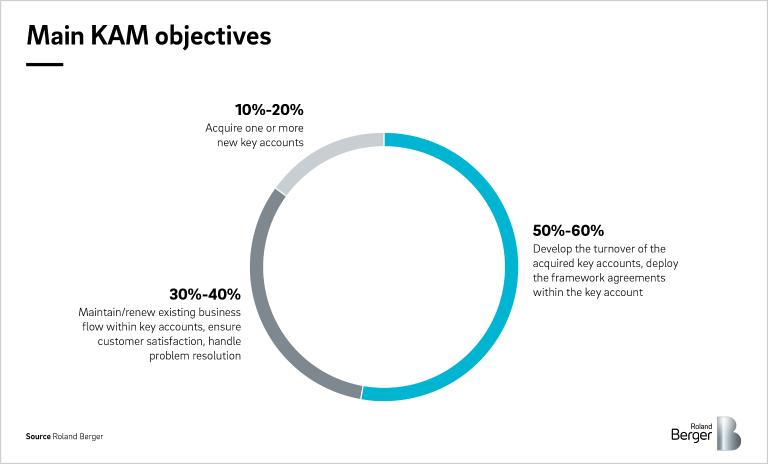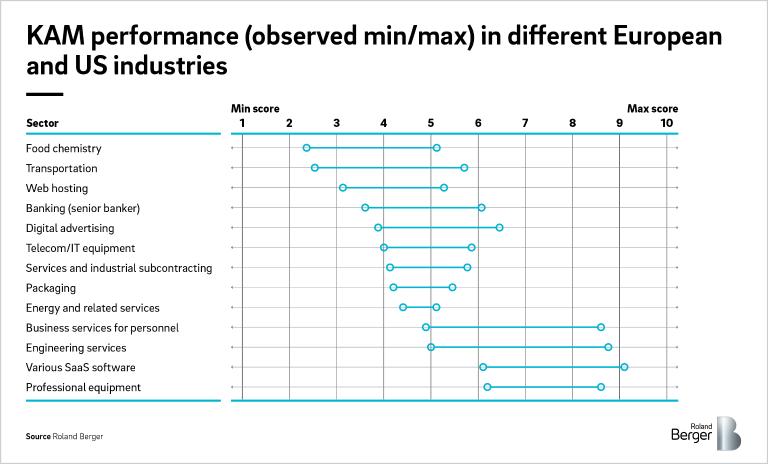Carve-outs are on the rise: Turbocharge your carve-out with performance improvement measures to boost value creation.


Key account management: Mind the gap
By Steffen Thiel and Martin Bodewig
Why some top KAM performers are pulling away from the rest – and how others can catch up
The gap between companies that are best-in-class in key account management and those whose KAM function is less effective is growing. In our new report, we look at the reasons behind the rise of the top performers and highlight three focus areas for companies that want to close the gap.

Few companies would argue that key account management (KAM) is not a crucial component of their business. As the main link between companies and their big suppliers, effective KAM helps firms to secure revenue, maximize margins and attract new customers.
But some companies do it better than others. Driven by the recent shift in the way suppliers are chosen, a gap has developed between the top KAM performers and others. The former have realized that KAM success now requires excellence in basic KAM practices, the establishment of activity standards and a rethinking of the traditional KAM profile. As a result, they are reaping the benefits.
In our report "Key account management: Learning from the best", we look at what makes a good and bad KAM performer, and describe the best-practice success factors in detail. A summary is given below.
What is KAM?
The KAM function is strategic, with the role of key account managers (KAMs) usually divided between three objectives:

The interactions between KAMs and clients, and between KAMs and their own organization, are generally defined by:
- The complexity of the respective organizations, and their geographic coverage
- The diversity of offers to be made to the customer
- The objectives of the business relationship
- The length of the business cycle and the complexity of the customer's processes
- Competitive intensity
- The existence or not of a technical sales support team to provide (or support) the technical content of tenders.
"Looking into increasing global competition, well executed key account management can be a decisive competitive advantage to safeguard or grow revenue levels for European players."
There is no "best practice" organizational model. However, we have found that a multi-contact structure (where a decision maker at the client has several contacts, not just the KAM) is often more commercially successful, albeit more demanding in terms of execution.
Why is there a performance gap?
The main reason behind the rise of top KAM performers is down to evolving customer behavior. The majority of major supplier decisions are now made in more integrated buying centers, where more factors are involved in determining the need for and specifications of potential suppliers and their products/services. This means suggestions for suppliers now come from across the management team. In addition, the process time between defining a need and issuing an order has increased, selection criteria have become more numerous and negotiations more complex. Top-performing KAM companies have moved with the times and adapted to these new criteria.
The performance gap between them and their competitors is growing as a result. In addition, gaps between different industries persist.
How to fill the gaps
To better understand the differences in performance, the full report explores the three areas where the gaps between the practices of high-performing industries and others are often significant. These are where the best excel.
Basic practices
While some basic KAM practices are generally well mastered in most sectors (management of annual account plans, relational grids), others remain at an average level. For example, account reviews are carried out only by sales representatives (no discussion of customer issues outside of the current business relationship) or CRM information is not fully leveraged. These weaknesses reflect a KAM organization that is overly focused on achieving the business objectives of the moment, and insufficiently focused on building a stronger long-term position with the client.
In the report, we look at the problems around long-term business relationships and how to mitigate risks. We illustrate the need for companies to rethink the role of KAM using a case study.
"Too many misconceptions prevent companies from upping their KAM game."
Defining activity levels
In transactional selling (short cycle sales/relatively lower average sales value), it is accepted that the level of activity, for example, the number of calls, proposals, appointments, campaigns, etc., has a quasi-linear effect on revenue. In KAM, on the other hand, the definition of activity levels, or quotas, is more problematic. Complex organizational charts, long sales cycles, coordination requirements, market size, fewer proposals - all of these factors can create a dizzying effect and prevent the establishment of activity standards.
A lack of activity standards tends to inhibit performance in KAMs, create a less sustained rhythm or result in the suboptimal allocation of commercial time. In the full report, we offer four rules to define activity levels by customer and by KAM, and outline how to apply an overall comprehensive account planning logic.
The new KAM profile
Allowing KAMs to hold their portfolio for an extended period of time is an understandable temptation. Fears such as “there’s no way to replace our KAM because they know the account too well” are common and explain why KAMs often keep the same clients for four years or more. But this damages performance.
In the full report, we assess the undesirable effects and demonstrate why companies should not be afraid to update the KAM profile, making it more balanced and focused on information gathering.
We conclude the report by outlining the steps and timeline involved in transforming a company’s KAM function to achieve a considerable boost in performance.
Register now to download the full PDF including key insights, new developments as well as future challenges regarding Key Account Management.






